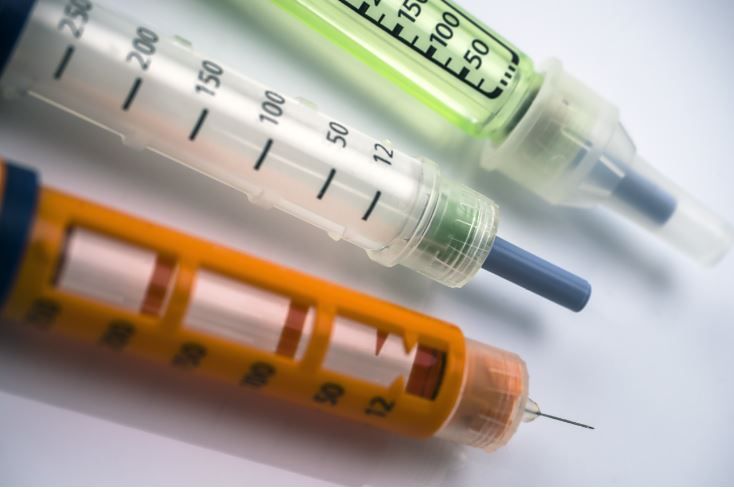Tirzepatide Found Safe, Effective as Add-on to Stable Basal Insulin in T2D Patients Not at Goal
Tirzepatide at 3 different doses significantly improved glycemic control and promoted weight loss when added to titrated insulin in patients with type 2 diabetes.
©felipecaparros/stock.adobe.com

When added to a stable, once-daily insulin glargine regimen in patients with type 2 diabetes (T2D) the investigational drug tirzepatide at 3 doses led to greater reductions in hemoglobin A1c (A1c) and body weight when compared with placebo.
The findings, from the SURPASS-5 trial, showed that >85% of participants in all 3 tirzepatide treatment groups (5 mg, 10 mg or 15 mg) reached A1c >7% at 40 weeks and that differences between each tirzepatide group and placebo were statistically significant.
Results were published online in JAMA on February 8, 2022.
SURPASS-5, part of the Lilly SURPASS clinical trial program of tirzepatide, a novel dual glucose-dependent insulinotropic polypeptide (GIP) and glucagon-like peptide-1 (GLP-1) receptor agonist, was a randomized phase 3 study in 475 adults with T2D with inadequate glycemic control while on treatment with once-daily insulin glargine, with or without metformin. The trial was conducted from August 30, 2019-January 13, 2021,
The primary endpoint of interest was the mean change from baseline in A1c after 40 weeks of treatment. Five key secondary endpoints included mean change in body weight and percentage of patients reaching prespecified A1c levels.
Investigators randomized participants in a 1:1:1 ratio to receive once-weekly subcutaneous injections of tirzepatide or volume-matched placebo (n=120) over 40 weeks. Tirzepatide treatment groups received 5 mg (n=116), 10 mg (n=119), or 15 mg (n=120). Tirzepatide was initiated at 2.5 mg for all participants and titrated by 2.5 mg every 4 weeks until the randomly assigned dose was reached.
Mean age of SURPASS-5 participants was 60 years, 44% were women, and mean A1c was 8.31%. Mean BMI was 33.4 kg/m2 and the average duration of diabetes was 13.3 years.
At week 40, the mean change from baseline in A1c across groups was −2.40% with 10-mg tirzepatide and −2.34% with 15-mg tirzepatide vs −0.86% with placebo (P<.001 for both). Mean change in A1c from baseline with 5 mg tirzepatide was slightly less but statistically significant at -2.11% (P<.001)
The mean change in body weight from baseline at week 40 across treatment groups was −5.4 kg with 5-mg tirzepatide, −7.5 kg with 10-mg tirzepatide, −8.8 kg with 15-mg tirzepatide vs 1.6 kg with placebo
Rodriguez et al report that the percentage of participants in the 3 treatment groups that reached A1c <7% at the 40-week mark ranged from 85% to 90% vs 34% in the placebo group (P<.001 for all). Further, approximately half those in the 15 mg terzepatide group and 42% in the 10 mg group reached an A1c <5.7% compared with 3% of those in the placebo group (P<.001 for both).
Safety findings reported for tirzepatide included diarrhea and nausea as the most common treatment-emergent adverse events at 12%-21% for the former (vs 10% for placebo) and 13-18% for the latter (vs 3% for placebo).
The investigators write that the results are “consistent with previously reported studies of tirzepatide and further validate its effectiveness” across diverse patient groups.
In contrast, writing in an editorial in the same issue of JAMA, Stuart Chipkin, MD, of the University of Massachusetts Amherst School of Public Health and Health Sciences, said SURPASS-5 leaves a number of questions unanswered. “The study did not compare tirzepatide with other treatments that could have been used to target the postprandial glycemic pattern of the study population,” he wrote. “Although patients are likely to embrace a medication with weight-loss outcomes, the protocol also leaves unanswered questions about reducing insulin and evaluating the comparative risk of adverse effects.”
He cautions that while the results do demonstrate the potential for clinical benefit with the dual GIP/GLP-1 receptor agonist and may help support approval of tirzepatide by the US Food and Drug Administration it may also introduce some uncertainty for clinicians about optimal patient selection.
Reference: Dahl D, Onishi Y, Norwood P, et al. Effect of subcutaneous tirzepatide vs placebo added to titrated insulin glargine on glycemic control in patients with type 2 diabetes: the SURPASS-5 randomized clinical trial. JAMA. 2022;327:534-545.